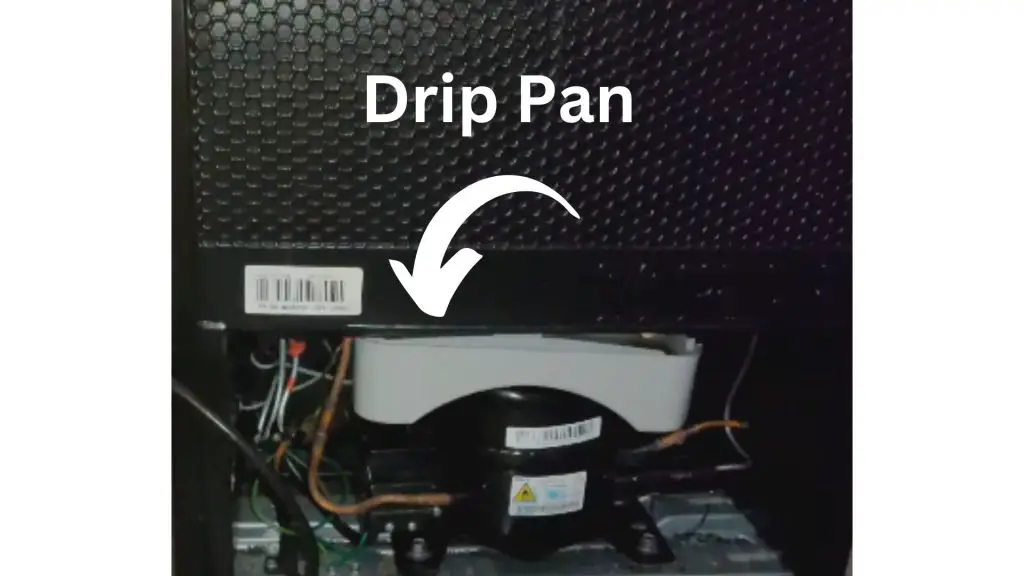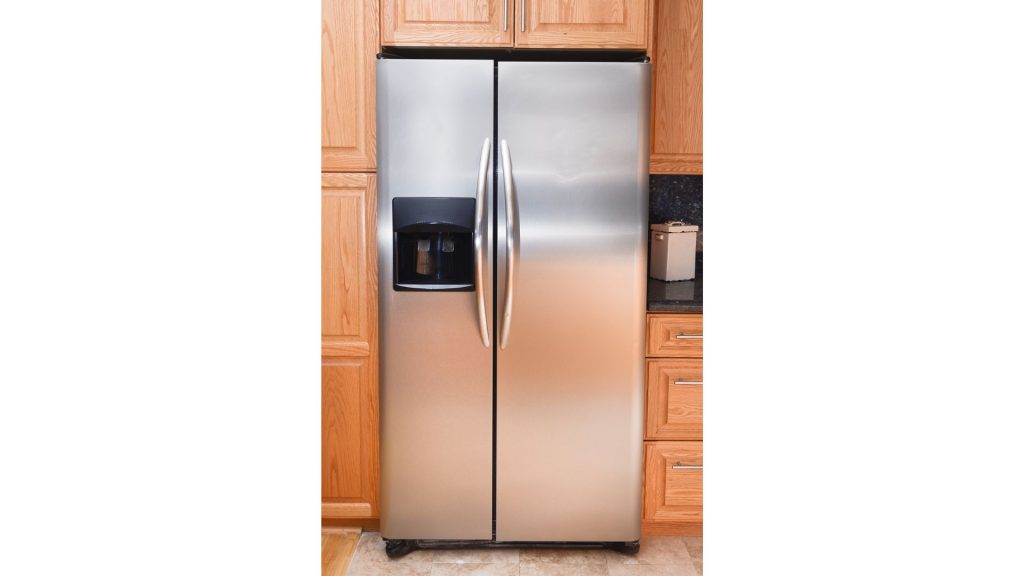Any device that makes ice is bound to leak from time to time. If you’ve noticed pools of water below your Hisense fridge, you can blame one or more of the following:
1). Clogged Drain
People expect appliances such as refrigerators to leak because of the low temperatures they create and maintain internally. Melting ice and condensing water can make a mess of things, which is why these devices have defrost drains.
These tubes take the water to a drip pan at the bottom. What happens when a defrost drain clogs? The Hisense fridge will leak. While various forms of debris can block the defrost drain, the most common culprit is ice buildup. The solution will depend on the cause you’ve identified:
- Unplugging the fridge can thaw the ice in the drain. This approach is very slow, particularly in the face of extensive ice buildup, but it works. Additionally, the solution is simple. You don’t have to take the fridge apart.
- A faster option involves flushing the defrost drain with warm water. You need a turkey baster, although a funnel will also work.
- Get a coat hanger, straighten it, and force the blockage out. Be careful. You may cause irreversible harm to the drain.
2). Cracked Drip Pan

You don’t have to empty the drip pan. The water it collects evaporates naturally. However, a significant leak may cause the drip pan to fill faster than the water can evaporate. The drip pan can also develop cracks, allowing the water it collects to spill onto the floor.
Start by inspecting the pan. If you see cracks and breaks, replace the pan. If the pan is full, empty it. But this is a temporary measure. Find out why the pan is full. Where is the water coming from at such an alarming rate? The pan will continue to overflow until you identify and resolve the underlying problem.
3). Leaked Water Line
If your fridge dispenses water, it has a supply line running to your home’s plumbing system. That line can leak. Inspect it. Do you see knicks and tears? What about blockages? Again, ice is a more common obstruction than conventional dirt and debris.
If you must perform a thorough investigation, unplug the fridge and close the valve to stop the water flow. Search every inch of the water line. Don’t limit your investigation to blockages and tears. Kinks are just as problematic.
In all cases, you are better off replacing the water line. Patches and repairs won’t do. You can’t trust them to stand the test of time. Clogging is the exception, but only if you can flush the obstructions out without damaging the line.
Don’t just force a hanger into the tube. Talk to a professional. They have the tools to remove the blockage while keeping the water line intact.
4). Dispenser Leak
- Water dispensers tend to leak. But you’re looking at a few drops at the most, not enough to make a noticeable puddle. This is not a cause for concern.
- Ice dispensers can contribute to this issue by allowing small ice pieces to fall out. The ice will melt, tricking the layperson into thinking that their appliance has a leak. This is not a cause for concern either.
- Dispensers have a water tank that expands and contracts due to temperature changes. As a result, the water will drip out of the dispenser. But again, this is not a problem. More importantly, you only see the issue in newly installed devices.
- The dispenser’s connection to the water line is loose. Tighten it.
- The water line has air. People with Samsung fridges solve this problem by dispensing two to three gallons of water. The solution applies to Hisense refrigerators.
5). High Temperature
A Hisense fridge will only satisfy your needs if it maintains low temperatures internally. This is the only way to preserve your food. What happens when temperatures rise? The ice will melt, and water will leak.
Temperatures can rise because of a dead compressor, dirty condenser coils, worn-out door seals, and more. The solution will depend on the problem. For instance, you can replace a worn-out door seal, fix a faulty compressor, clean dirty condenser coils, adjust the temperature, replace a faulty thermostat, etc. If temperatures continue to climb, your food will die.
Steps To Prevent Water Leaks In Hisense Fridge
Don’t wait for a Hisense fridge to leak to take action. Water damage is serious. You can probably afford to replace a wet carpet before it develops mold. But what if water from the fridge spills into a power strip? Don’t take any chances. Use the following steps to prevent such disasters before they occur:
1). Level the Fridge

Many people blame leaks on blocked defrost drains, broken drip pans, and the like. They don’t realize that an uneven surface can contribute to this issue. If you have jugs, cups, and bottles of water in the fridge, an uneven surface can tilt the fridge, sending those containers to the floor and causing a spill.
Therefore, make sure this appliance is level. Place makeshift wedges under one or more legs to prevent a Hisense fridge from tilting.
2). Close the Door
Leaks can occur because the temperature is rising. The temperature will rise because you left the door open. Fight this habit. You should only open the door when you need something. Close it the moment you get what you want. Take a moment to apply gentle pressure.
Don’t leave without confirming that the door is closed. And if the door won’t close securely, replace it before the fridge’s functions suffer.
3). Check the Seal
Some doors refuse to close because the seal is worn out or damaged. Check the seal routinely, and replace it once you notice signs of wear and tear. A worn-out seal will increase your electricity bill because the Hisense fridge is working harder to keep the interior cool.
4). Perform Maintenance
American Appliance Repair recommends maintenance for your fridge every three months. Technically, these appliances can get by without maintenance. However, the following will keep the repair man away:
- Clean the door seal with soapy water. Dirt and mold can damage the seal, increasing the rate at which it wears out.
- Clean the condenser coils. You will find them at the back. Dirty condenser coils make the fridge less efficient.
- Check the fridge’s surface. Make sure the appliance is level. The fridge might have been level when you first installed it, but that can change after a few months.
- Check the temperature settings. They should fit the recommendations in the manual.
- Re-arrange the food to avoid overcrowding. Don’t block the vents. This will raise the temperature by interfering with the airflow.
5). Check the Drip Pan
Keep an eye on the drip pan. If it looks full, troubleshoot the fridge and identify the factors generating the water. If the pan has cracks, replace it before it leaks.
Call a professional whenever you notice symptoms you can’t explain, such as strange noises. They can identify and resolve issues that cause leaks before they evolve into serious problems.
Is A Leaking Hisense Fridge Covered By Warranty?
Hisense warranties are fairly straightforward. They follow the same rules you find in warranties from other brands. For instance, they don’t cover defects that appear because you neglected or mishandled their fridge.
These exceptions apply to shipment damage, accidents, and, most importantly, improper installation. In other words, if things go wrong because you failed or forgot to follow the instructions during installation, the Hisense warranty won’t cover you.
Additionally, they don’t cover leaks resulting from damaged or frozen pipes. Unless the leak is part of a factory defect, the warranty won’t help you. You will void your warranty if you allow other people to tamper with the appliance.
This Hisense guide explores all the exceptions you will encounter where your warranty is concerned in greater detail.

